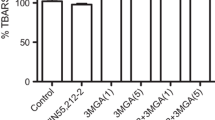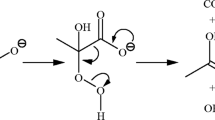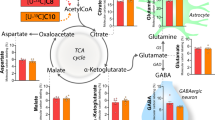Abstract
Free radical induced lipid peroxidation may play a role in neurodegeneration and peroxidation leads to the formation of hexanal from ω-6 fatty acids. We have previously demonstrated in vitro that pyruvate dehydrogenase (PDH) catalyzes the condensation of saturated aldehydes with pyruvate to form acyloins. We have further shown in perfused rat heart that hexanal, presumably via PDH, is converted to 3-hydroxyoctan-2-one and that it in turn can be reduced to 2,3-octanediol. We now extend this work using intra-striatal microdialysis to show that this reaction also occurs in rat brain. The reduction of hexanal to hexanol was also evaluated. Microdialysis probes were implanted bilaterally in the striatum and were infused with hexanal with and in the absence of added pyruvate. Analysis of microdialysis samples showed a release of 3-hydroxyoctan-2-one (9.5-10.5 pmol/min), 2,3-octanediol (2.2-2.7 pmol/min) and hexanol (64-74 pmol/min). Pyruvate addition did not increase 3-hydroxyoctan-2-one or 2,3-octanediol production. In a second series of experiments where no exogenous hexanal was infused, endogenous production of 3-hydroxyoctan-2-one (1.0-1.3 pmol/min) and 2,3-octanediol (1.0-1.2 pmol/min) was still observed, although no hexanol was detected. We also investigated the possibility that oxidative stress induced by 1-methyl-4-phenylpyridinium (MPP+) would increase lipid peroxidation resulting in increased production of 3-hydroxyoctan-2-one. Analysis of samples collected following MPP+ infusion indicated no additional increase suggesting that brief exposure to MPP+ does not increase hexanal formation over baseline levels during the experimental period.
Similar content being viewed by others
REFERENCES
Adams, J.D., Odunze, I.N. and Sevanian, A. (1989). Induction by 1-methyl-4-phenyl-1,2,3,6-tetrahydropyridine of lipid peroxidation in vivoin Vitamin E deficient mice. Biochem. Pharmacol. 39:R5-R8.
Adams, J.D. and Odunze, I.N. (1991). Biochemical mechanisms of 1-methyl-4-phenyl-1,2,3,6-tetrahydropyridine toxicity. Could oxidative stress be involved in the brain? Biochem. Pharmacol. 41:1099–1105.
Althaus, J.S., Andrus, P.K., Williams, C.M., von Voigtlander, P.F., Cazers, A.R. and Hall, E.D. (1993). The use of salicylate hydroxylation to detect hydroxyl radical generation in ischemic and traumatic brain injury. Reversal by tirilazad mesylate (U-74006F). Mol. Chem. Neuropathol. 20:147–162.
Brophy, P.M. and Barrett, J. (1990). Detoxification of secondary products of lipid peroxidation in the cytosol of a mouse fibroblast cell line. Biochem. Cell. Biol. 68:1288–1291.
Butterworth, R.F., Kril, J.J. and Harper, C.G. (1993). Thiamine-dependent enzyme changes in the brains of alcoholics: Relationship to the Wernicke-Korsakoff syndrome. Alcohol. Clin. Exp. Res. 17:1084–1088.
Canuto, R.A., Ferro, M., Muzio, G., Bassi, A.M., Leonarduzzi, G., Maggiora, et al.(1994). Role of aldehyde metabolizing enzymes in mediating effects of aldehyde products of lipid peroxidation in liver cells. Carcinogenesis 15:1359–1364.
Cummings, P., Brown, E., Damsma, G. and Fibiger, H. (1992). Formation and clearance of interstitial metabolites of dopamine and serotonin in the rat striatum; an in vivomicrodialysis study. J. Neurochem. 59:1905–1914.
Czok, R. and Lamprecht, W. In: (H.U. Bergmeyer, ed.) Methods of Enzymatic Analysis. New York: Verlag Chemie, Academic Press; 1974: 146.
Desole, M. S., Esposito, G., Fresu, L., Migheli, R., Enrico, P., Miele, P., et al.(1993). Correlation between 1-methyl-4-phenylpyridinium ion (MPP+) levels, ascorbic acid oxidation and glutathione levels in the striatal synaptosomes of the 1-methyl-4-phenyl-1,2,3–6-tetrahydropyridine (MPTP)-treated rat. Neurosci. Lett. 161:121–123.
Des Rosiers, C., Rivest, M.J., Boily, M. J., Jetté, M., Carrobé-Cohen, A. and Kumar, A. (1993). Gas chromatographic-mass spectrometric assay of tissue malondialdehyde, 4-hydroxynonenal, and other aldehydes after their reduction to stable alcohols. Anal. Biochem. 208:161–170.
Esterbauer, H. (1982). Aldehydic products of lipid peroxidation. In: (D.C.H. McBrien, T.F. Slater, eds.) Free Radicals: Lipid Peroxidation and Cancer. London: Academic Press: 101–158.
Esterbauer, H., Zollner, H., Schaur, R.J. (1990). Aldehydes formed by lipid peroxidation; Mechanisms of formation, occurrence, and determination. In (C. Vigo-Pelfrey, ed.) Membrane Lipid Oxidation. Boca Raton, FL: CRC Press:239–268.
Evans, P.H. (1994). Nutrient and toxin interactions in neurodegenerative disease. Proc. Nutr. Soc. 53:431–442.
Fahn, S. and Cohen, G. (1992). The oxidant stress hypothesis in Parkinson's disease: evidence supporting it. Ann. Neurol. 32:804–812.
Gabriel, M.A., Jabara, H. and Al-Khalidi, U.A.S. (1971). Metabolism of acetoin in mammalian liver slices and extracts. Biochem. J. 124:793–800.
Good, P.F., Hsu, A., Werner, P., Perl, D and Olanow, C.W. (1998). Protein nitration in Parkinson's disease, J. Neuropath. Exp. Neurol. 57:338–342.
Götz, M., Freyberger, P. and Riederer, D. (1990). Oxidative stress: a role in the pathogenesis of Parkinson's disease. J. Neural Transm. 29:241–249.
Green, D.E., Westerfeld, W.W., Vennesland, B. and Knox, W.E. (1942). Carboxylases of animal tissues. J. Biol. Chem. 145:69–84.
Ishikawa, T., Esterbauer, H. and Sies, H. (1986). Role of cardiac glutathione transferase and of glutathione S-conjugate export system in biotransformation of 4-hydroxynonenal in the heart. J. Biol. Chem. 261:1576–1581.
Hall, E.D., Andrus, P.K. and Yonkers, P.A. (1993). Brain hydroxyl radical generation in acute experimental head injury. J. Neurochem. 60:588–594.
Halliwell, B. and Gutteridge, J.M.C. (1984). Oxygen toxicity, oxygen radicals, transition metals and disease. Biochem. J. 219:1–14.
Heikkila, R.E., Nicklas, W.J., Yvas, I. and Duvoisin, R.C. (1985). Dopaminergic toxicity of rotenone and the 1-methyl-4-phenylpyridinium ion after their stereotaxic administration to rats: Implication for the mechanism of 1-methyl-4-phenyl-1,2,3,6-tetrahydropyridine toxicity. Neurosci. Lett. 62:389–394.
Heikkila, R.E. (1988). 1-Methyl-4-phenyl-1,2,3,6-tetrahydropyridine (MPTP) a dopaminergic neurotoxin. Neurotransmissions IV-1:1–4.
Hung, H.C. and Lee, E.H.Y. (1998). MPTP produces differential oxidative stress and antioxidative responses in the nigrostriatal and mesolimbic pathways. Free Rad. Biol. Med. 24:76–84.
Luo, X.P., Yazdanpanah, M., Bhooi, N. and Lehotay, D.C. (1995). Determination of aldehydes and other lipid peroxidation products in biological samples by gas chromatography-mass spectrometry. Anal. Biochem. 228:294–298.
Marzatico, F., Cafe, C., Taborelli, M. and Benzi, G. (1993). Experimental Parkinson's disease in monkeys. Effect of Ergot alkaloid derivative on lipid peroxidation in different brain areas. Neurochem. Res. 18:1101–1106.
Montgomery, J., Jetté, M. and Brunengraber, H. (1990). Assay of physiological levels of 2,3-butanediol diastereomers in blood and urine by gas chromatography-mass spectrometry. Anal. Biochem. 185:71–76.
Montgomery, J., Des Rosiers, C. and Brunengraber, H. (1992). Biosynthesis and characterization of 3-hydroxyalkan-2-ones and 2,3-alkanediols: Potential products of aldehyde metabolism. Biol. Mass Spectrom. 21:242–248.
Montgomery, J., Jetté, M., Huot, S. and Des Rosiers, C. (1993). Acyloin production from aldehydes in the perfused rat heart: The potential role of pyruvate dehydrogenase. Biochem. J.294:727–733.
Montgomery, J.A., David, F., Garneau, M. and Brunengraber, H. (1993). Metabolism of 2,3-butanediol stereoisomers in the perfused rat liver. J. Biol. Chem. 288:20185–20190.
Obata, T. and Chiueh, C.C. (1992). In vitro trapping of hydroxyl free radicals in the striatum utilizing intracranial microdialysis perfusion of salicylate: Effects of MPTP, MPDP+and MPP+. J. Neural Transm. 89:139–145.
Olanow, C.W. (1992). An introduction to the free radical hypothesis in Parkinson's disease. Ann. Neurol. 32:S2-S9.
Olanow, C.W. (1993). A radical hypothesis for neurodegeneration. TINS 16:439–444.
Paxinos, G. and Watson, C. (1986). The rat brain in stereotaxic co-ordinates, 2nd ed. Toronto: Academic Press.
Poirier, J., Dallaire, L. and Barbeau, A. (1986). Parkinson's disease and free radicals. In: (C. Rice-Evans, ed.) Free Radicals, Cell Damage and Disease. Paris: Richelieu Press; 273–293.
Poirier, J. and Thiffault, C. (1993). Are free radicals involved in the pathogenesis of idiopathic Parkinson's disease? Eur. Neurol. 33:38–43.
Pontén, U., Ratcheson, R.A., Salford, L.G. and Siesjö, B.K. (1973). Optimal freezing conditions for cerebral metabolites in rats. J. Neurochem. 21:1127–1138.
Rojas, P. and Rios, C. (1993). Increased striatal lipid peroxidation after intra-cerebroventricular MPP+administration to mice. Pharmacol. Toxicol. 72:364–368.
Singh, R.J., Karouli, H., Gunther, M., Beckman, J.S., Mason, R. and Kalyanaraman, B. (1998). Reexamination of the mechanism of hydroxyl radical adducts formed from the reaction between familial amyotrophic lateral sclerosis-associated Cu,Zn superoxide dismutase mutants and H2O2. Proc. Natl. Acad. Sci. USA: 95:6675–6680.
Ste-Marie, L., Boismenu, D, Vachon, L. and Montgomery, J. (1996). Evaluation of sodium 4-hydroxybenzoate as an hydroxyl radical trap using gas chromatography-mass spectrometry and high-performance liquid chromatography with electrochemical detection. Anal. Biochem. 241:67–74.
Sun, G.Y. and MacQuarrie, R.A. (1989). Deacylation-reacylation of arachidonoyl groups in cerebral phospholipids. Ann. N.Y. Acad. Sci. 559:37–55.
Thiffault, C., Aumont, N., Quirion, R. and Poirier, J. (1995). Effect of MPTP and 1-deprenyl on antioxidant enzymes and lipid peroxidation levels in mouse brain. J. Neurochem. 65:2725–2733.
Toyokuni, S., Luo, X.-P., Tanaka, T., Uchida, K., Hiai, H. and Lehotay, D. (1997). Induction of a wide range of C2–12aldehydes and C7–12acyloins in the kidney of Wistar rats after treatment with a renal carcinogen, ferric nitrilotriacetate. Free Radic. Biol. Med. 22: 1019–1027.
Ullrich, O., Grune, T., Henke, W., Esterbauer, H. and Siems, W.G. (1994). Identification of metabolic pathways of the lipid peroxidation product 4-hydroxynonenal by mitochondria from rat kidney cortex. FEBS Letts. 352:84–86.
Veech, R.L., Felver, M.E., Lakshmanan, M.R. and Huang, M,-T. (1981). Control of a secondary pathway of ethanol metabolism by differences in redox state: A story of the failure to arrest the Krebs cycle for drunkenness. Biological Cycles: Current Topics Cell. Reg. 18:151–179.
Veech, R.L., Gitomer, W.L. and Casazza, J.P. (1987). Metabolic pathways leading to diol formation. Prog. Clin. Biol. Res. 241:185–199.
White, B.C., Grossman, L.I. and Krause, G.S. (1993). Brain injury by global ischemia and reperfusion: A theoretical perspective on membrane damage and repair. Neurology 43:1656–1665.
Youdim, M.B.H. and Riederer, P. (1993). The role of iron in senescence of dopaminergic neurons in Parkinson's disease. J. Neural Transm. 40:57–67.
Zhang, J. and Piantadosi, C.A. (1994). Prolonged production of hydroxyl radical in rat hippocampus after brain ischemia-reperfusion is decreased by 21-aminosteroids. Neurosci. Lett. 177:127–130.
Author information
Authors and Affiliations
Rights and permissions
About this article
Cite this article
Jaar, V., Ste-Marie, L. & Montgomery, J.A. Striatal Metabolism of Hexanal, a Lipid Peroxidation Product, in the Rat. Metab Brain Dis 14, 71–82 (1999). https://doi.org/10.1023/A:1020701612639
Issue Date:
DOI: https://doi.org/10.1023/A:1020701612639




